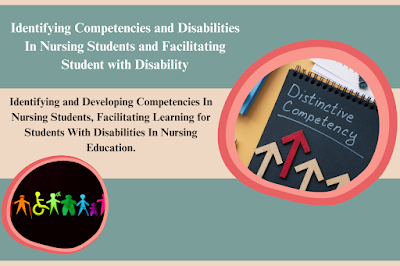Nursing Students and Facilitating Student with Disability and Identifying Competencies and Disabilities
Identifying and Developing Competencies In Nursing Students
Once the expected program outcomes have been established, the next step in the curriculum development process is to identify the competencies that students need to possess to attain these outcomes. Competency statements identify the knowledge, skills, and professional attitudes and values that students need to develop if they are to achieve the program outcomes.
Competency statements are behaviorally anchored and student focused. Nursing faculty must approach curriculum development from the premise that nursing knowledge and skills are built on or interwoven with general education knowledge and skills.
Outcomes should include those competencies that are specific to the nursing discipline, as well as those competencies that establish a foundation for lifelong learning. Students achieve the identified competencies, through acquisition of necessary KSAs, leading to the achievement of the expected program outcomes, whether as an undergraduate or graduate student.
Competency statements are important in assessing student learning because they become the foundation that drives evaluation. When identifying competencies, faculty should pay attention to determining the right student, the right behavior, the right level of behavior, and the right context of the behavior.
Here, student refers to the level of student from whom faculty are expecting these behaviors (eg, pre nursing, nursing sophomore, nursing senior, master's or doctoral level, etc.); level of behavior refers to the level of learning or performance at which the behavior is to be demonstrated (this is where learning taxonomies are helpful); and context of the behavior refers to the environment in which the behavior should occur.
For example, if faculty believe that it is essential for students to exhibit a particular skill, knowledge, or attitude across a continuum of health care settings or with a select population of patients, then the competency statement should indicate the parameters in which the behavior should be expressed.
It is equally important for faculty to remember not to be so specific as to “paint themselves into a corner” from which there is no escape (eg, if faculty specify that a certain behavior will be demonstrated with postoperative patients in an outpatient surgical setting, all students must be guaranteed this type of experience for faculty to make an accurate and consistent assessment and evaluation of student performance).
Facilitating Learning for Students With Disabilities In Nursing Education
More than 40 years ago, Congress passed the Rehabilitation Act (1973). This act states that any program or activity that receives federal funding cannot deny access or participation to individuals with disabilities. Section 504 of this act specifically addresses higher education and prohibits public postsecondary institutions that receive federal funds from discriminating against individuals with disabilities.
Furthermore, more than 20 years ago Congress enacted the Americans with Disabilities Act (ADA) (1990). This act was further updated in 2008 and is now sometimes referred to as the ADA Amendments Act of 2008 (ADAAA). A summary of key provisions has been published to facilitate use of the Act's provisions (Summary of key provisions, nd).
Because of these two laws, colleges and universities have experienced an increased number of students with disabilities admitted to their programs, including nursing programs. In the 2008–2009 academic year, more than 640,000 students with disabilities were enrolled across all levels of postsecondary education (National Center for Education Statistics, 2011).
Although the numbers of nursing students were not isolated within these data, one can assume that the numbers provided included nursing students enrolled in prelicensure and post licensure programs. Dealing with students who have disabilities is not unique to the United States. The Discrimination Act of 1995, with amendments in 2005, and the Nursing and Midwifery Council 2006 standards guide nursing educators in the United Kingdom in educating nursing students with disabilities (Tee et al., 2010).
Nursing students with special needs present a challenge to nursing faculty in both the classroom and clinical settings. Students who have special needs include those who have a physical disability such as a visual, hearing, or mobility impairment; a chronic illness; a learning disability; or a chemical dependency problem.
Many nursing programs have had experience in meeting the needs of these students. For example, a recent study by Betz, Smith, and Bui (2012) estimated from a survey of 65 nursing programs in California that approximately 5% of students across associate degree programs, 2% of baccalaureate students, and 0.6% of master's students had some form of disability.
Learning disabilities were the most common type of disability reported. Betz et al. (2012, p. 680) also found that the majority of the students did not disclose their disability prior to admission. Although many students with disabilities are enrolled in nursing programs, faculty often have reservations about their ability to deliver safe patient care.
A nationwide survey of baccalaureate programs revealed that nursing educators preferred able-bodied students (Aaberg, 2012). Others, such as Dupler, Allen, Maheady , Fleming, and Allen (2012) have challenged nursing faculty to adopt a more open approach to accommodating students with disabilities.
In fact, Griffiths, Worth, Scullard , and Gilbert (2010) suggested that a multifaceted approach to working with students who have disabilities includes holistic, student centered strategies and encouraged the involvement of practice partners in providing appropriate clinical experiences. Wood and Marshall's (2010) survey of nursing leaders echoed Griffiths et al. (2010).
Wood and Marshall found that nurse managers rated the performance of nurses with disabilities as “exceptional or above average” (p. 182). Furthermore, they discovered that the environment and attitudes of co workers could hamper work performance despite the fact that accommodations most likely could have been made.
As more students with disabilities seek admission to nursing programs, and as those within the profession age, retaining nurses with disabilities in the workforce will be essential. Patient safety concerns notwithstanding, without an open attitude toward students with disabilities, much nursing talent may be lost.




Give your opinion if have any.